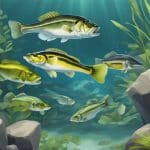Types Of Trout
Trout are one of the most popular freshwater fish species in North America, and for good reason. With their beautiful colors and delicious taste, they are a favorite among anglers and fish enthusiasts alike. There are many different types of trout, each with their unique characteristics, habitats, and behaviors.
Diversity of Trout Species
Trout species can be found in a variety of environments, from cold mountain streams to large lakes and rivers. Some of the most common species of trout include rainbow trout, brown trout, brook trout, cutthroat trout, and lake trout. Each species has its unique features and characteristics, making them a fascinating subject for study and exploration.
Trout Habitats and Distribution
Trout can be found throughout North America, from the cold waters of Alaska to the warm streams of Mexico. They are typically found in clear, cold water with high oxygen levels, and they prefer areas with plenty of cover and structure. Understanding the habitat and distribution of different trout species is essential for successful fishing and conservation efforts.
Key Takeaways
- Trout are a diverse group of freshwater fish species found throughout North America.
- Different species of trout have unique characteristics, habitats, and behaviors.
- Understanding the habitat and distribution of different trout species is essential for successful fishing and conservation efforts.
Diversity of Trout Species

Trout are a popular game fish found in North America, Europe, and Asia. There are many different species of trout, each with unique characteristics and habitats. In this section, we will explore the diversity of trout species, including their native ranges, introduced populations, and physical attributes.
Native Trout of North America
North America is home to several species of native trout, including brown trout, brook trout, rainbow trout, cutthroat trout, golden trout, bull trout, lake trout, dolly varden trout, apache trout, and gila trout. These species are found in rivers, streams, and lakes throughout the United States and Canada.
Brown trout are native to Europe but were introduced to North America in the late 1800s. They are now found in many rivers and lakes throughout the continent. Brook trout are native to eastern North America and are found in cold, clear streams and lakes. Rainbow trout are native to the western United States and are now found throughout North America. Cutthroat trout are native to the western United States and are known for their distinctive red slash under their jaw.
European and Asian Trout
Europe and Asia are home to several species of trout, including brown trout, rainbow trout, and steelhead trout. Brown trout are native to Europe and Asia and have been introduced to North America. Rainbow trout are native to the western United States but have been introduced to Europe and Asia. Steelhead trout are a sea-run form of rainbow trout and are found in the Pacific Ocean and its tributaries.
Trout Introduced to Non-Native Regions
Trout have been introduced to many non-native regions around the world for recreational fishing purposes. For example, brown trout have been introduced to New Zealand and Australia, where they have become established populations. Lake trout have been introduced to the Great Lakes in North America, where they have become an important commercial fishery. Lahontan cutthroat trout and California golden trout are two examples of native North American trout species that have been introduced to non-native regions for conservation purposes.
In conclusion, trout are a diverse group of fish with many different species found throughout the world. Understanding their native ranges, physical attributes, and habitats is important for conservation and management efforts.
Trout Habitats and Distribution
Trout are a diverse group of fish found in a variety of habitats around the world. They are known for their preference for cold, clear, and well-oxygenated water. In North America, trout are found in both freshwater and saltwater environments.
Freshwater Systems
Trout are commonly found in freshwater systems such as rivers, streams, and mountain lakes. In the United States, trout can be found in the Rocky Mountains, Great Lakes, and Western North America. In Canada, trout are found in cold waters throughout the country.
Trout require clean water to survive and are often used as indicators of the health of aquatic ecosystems. They are sensitive to changes in water quality and temperature. Trout populations can decline rapidly due to pollution, habitat destruction, and overfishing.
Trout in Oceanic and Saltwater Environments
Some species of trout can also be found in oceanic and saltwater environments. In the Pacific Northwest, for example, steelhead trout are known for their anadromous behavior, meaning they migrate from the ocean to freshwater rivers to spawn.
In Europe, sea trout can be found in coastal waters and estuaries. These fish are known for their silver coloration and are highly prized by anglers.
Overall, trout are a fascinating group of fish with a wide distribution around the world. Their preference for cold, clean water makes them important indicators of aquatic ecosystem health.
Physical Characteristics and Identification
Trout are a diverse group of fish that come in various shapes, sizes, and colors. They are known for their streamlined body shape, forked tail, and parr marks. Identifying different types of trout can be challenging, but with a little knowledge of their physical characteristics, it becomes easier.
Coloration and Markings
Trout are often identified by their unique coloration and markings. Brown Trout, for example, have a brown or golden hue and numerous black, brown, and red spots. Rainbow Trout, on the other hand, have a silver body with a pinkish stripe down their sides and black spots. Brook Trout have a dark green body with lighter, worm-like markings on their back and dorsal fin.
Body Shape and Fin Structure
Trout have a streamlined body shape that allows them to move quickly through the water. They also have a forked tail that provides them with excellent maneuverability. The dorsal fin of a trout is located on its back and is typically spotted or colored. The adipose fin, located between the dorsal fin and the tail, is often used to identify different species of trout.
In conclusion, identifying different types of trout requires an understanding of their physical characteristics, including coloration, markings, body shape, and fin structure. By paying attention to these features, anglers and enthusiasts can differentiate between different species of trout and appreciate their unique beauty.
Trout Life Cycle and Reproduction
Trout are a type of freshwater fish that have a unique life cycle. Understanding their life cycle is important for both anglers and conservationists. In this section, we will explore the different stages of the trout life cycle and their reproduction.
Spawning Behavior
Trout spawn in freshwater rivers and streams, usually in the fall or winter months. During the spawning season, male trout will develop a hooked jaw and bright colors to attract females. Once a female has chosen a mate, they will begin to build a nest in the riverbed called a redd. The female will lay her eggs in the redd, and the male will fertilize them.
After fertilization, the eggs will incubate for several months before hatching into alevins. Alevins are small, yolk-sac larvae that will eventually develop into fry. Fry are capable of feeding on their own and will grow rapidly during their first year of life.
Growth and Development
Trout can grow quickly, depending on their environment and species. Some subspecies of trout, such as rainbow trout, can grow up to an inch per month during their first year of life. As they continue to grow, they will eventually reach maturity and begin to reproduce themselves.
Trout that live in the ocean, known as anadromous trout, will migrate back to freshwater rivers and streams to spawn. However, hatcheries have also been established to help increase trout populations. These hatcheries will artificially spawn trout, incubate the eggs, and raise the fry until they are large enough to be released into the wild.
In conclusion, understanding the life cycle and reproduction of trout is crucial for anglers and conservationists alike. By protecting their spawning grounds and ensuring healthy populations, we can help ensure that trout will continue to thrive for generations to come.
Fishing Techniques and Conservation
Popular Trout Fishing Methods
Trout fishing is a popular activity for anglers across North America, and there are several techniques that are commonly used to catch these fish. One of the most popular methods is fly fishing, which involves using a lightweight lure that imitates the insects that trout feed on. This requires a bit of skill and practice, but it can be very effective for catching trout.
Other common techniques for catching trout include spin fishing, bait fishing, and trolling. Spin fishing involves using a spinning lure or bait to attract the fish, while bait fishing involves using live or artificial bait on a hook. Trolling involves dragging a lure or bait behind a moving boat to attract fish.
Conservation Efforts and Sustainable Practices
Trout populations are facing a number of threats, including habitat loss, pollution, and overfishing. As a result, many states have implemented conservation efforts to protect these fish and their habitats.
One of the most important conservation efforts is the protection of endangered and threatened trout species. Many states have designated certain species as their state fish, and have implemented regulations to protect them from overfishing and other threats.
In addition to protecting individual species, there are also a number of sustainable practices that anglers can follow to help preserve trout populations. These include catch-and-release fishing, using barbless hooks, and avoiding fishing during spawning season.
By following these practices and supporting conservation efforts, anglers can help ensure that trout populations remain healthy and sustainable for future generations to enjoy.






